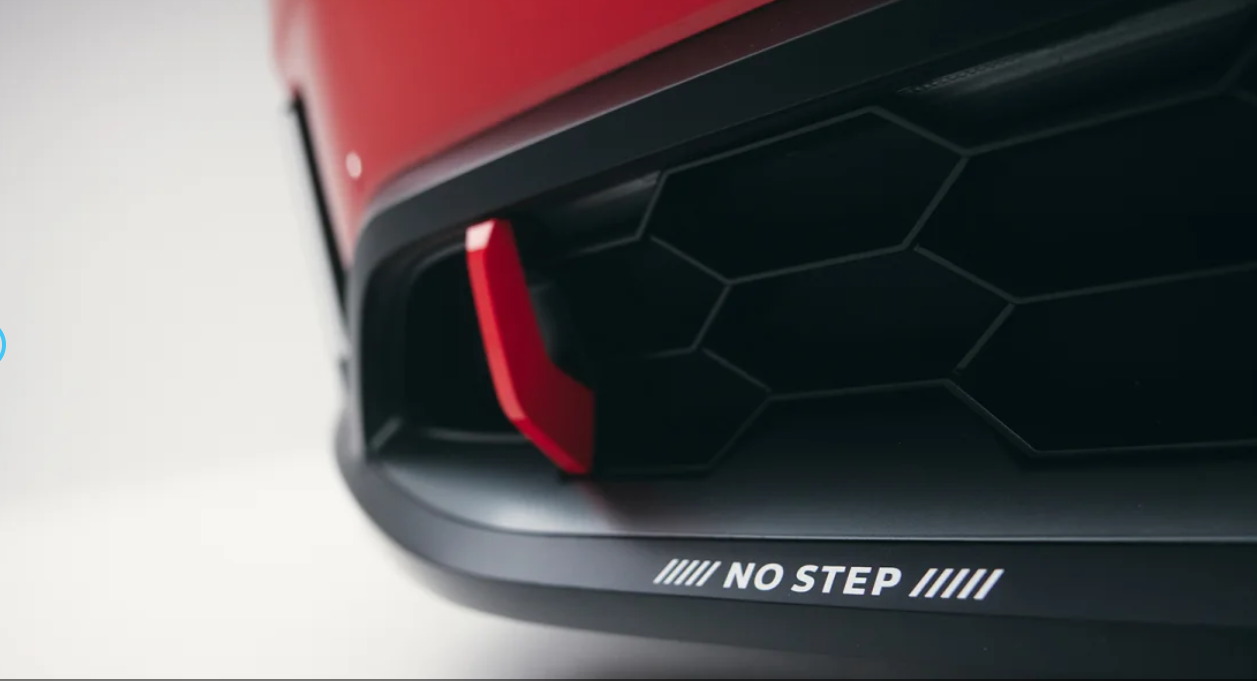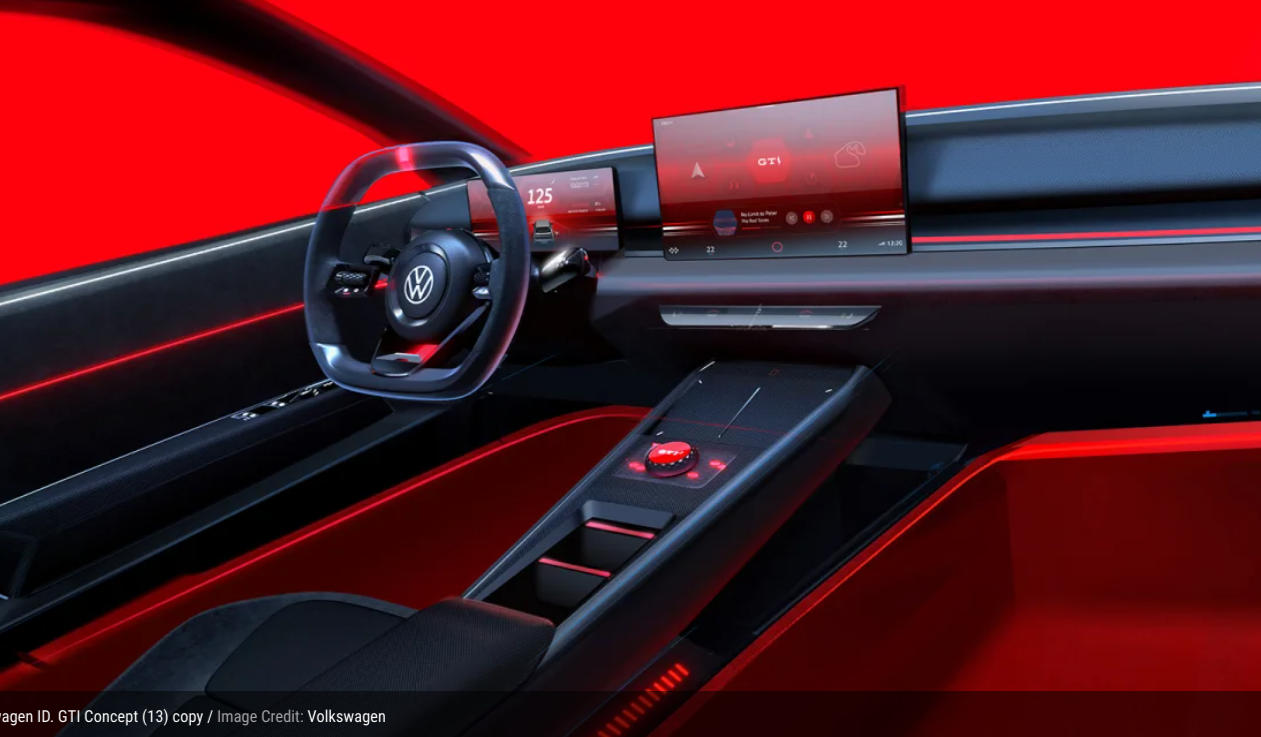
In September,1975, Volkswagen introduced the Golf GTI at the IAA auto show in Germany. The car got rave reviews and ignited what came to be known as the “hot hatch” segment of the new car market. In June, 1976, the first production version of the Golf GTI went on sale, priced at 13,850 DM, equivalent to 7,081 euros.

Courtesy of Volkswagen
The distinguishing features of the Golf GTI were a fuel-injected gasoline engine packing 110 PS (108 hp), a red stripe around the grille, black fender flares, tartan plaid seats, a sport steering wheel, and a shift knob that looked like a golf ball. In fact, head designer Herbert Schäfer — an avid golfer — was the first to stick a golf ball (it was a Volkswagen Golf, after all) on the end of the gear shift lever.
The company was unsure what the public reaction to a reasonably priced performance version of the standard Golf (known originally as the Rabbit in North America) would be, and so the initial production run was limited to 5000 vehicles. To date, nearly a half million of them have been manufactured, making the Golf GTI one of the most successful pocket rockets in automotive history.
The ID. GTI Is Revealed
That success has created a dilemma for Volkswagen as it transitions to electric vehicles. Is there a place for a hotted up hatchback in the ID. family? The answer, apparently, is yes. 47 years after the original Golf GTI appeared at IAA, Volkswagen has introduced the ID. GTI Concept at this year’s IAA show.
Official details are scarce. Although, CarWow is reporting the ID. GTI will be based on the ID. 2all, which is about the size of the current Volkswagen Polo at 160.4 inches (4070 mm) long with a wheelbase of 100.7 inches (2558 mm). It is 1.4 inches (36 mm) taller than the current Golf GTI. The ID. GTI is expected to be introduced in about 3 years time as a 2027 model.
The spice comes from a 320 hp electric motor, which should give drivers the kick in the pants they crave when they apply their boot to the exhilarator. Range is said to be around 250 miles (depending on how aggressively the go pedal is employed). And here’s the best part: the price is rumored to be 25,000 euros, which is more or less equivalent to what the original Golf GTI cost in 1976 if you factor in 46 years worth of inflation.
In a press release, Thomas Schäfer, CEO of the Volkswagen brand, sums up the fascination with GTI cars. “The perfect combination of driving pleasure and everyday usability — that is what the three letters GTI have meant for decades. With the ID. GTI Concept, we are transporting the GTI DNA into the electric age.
“It remains sporty, iconic, technologically progressive and accessible, but now has a new interpretation for tomorrow’s world — electric, fully connected and extremely emotive. Here, driving pleasure and sustainability are a perfect match. This means GTI has a future — for our brand and for the fans. Production has already been decided as part of our electric offensive. A Volkswagen sports car for the electric age that is suitable for everyday driving — 100 per cent electric, 100 per cent emotion.”
Based On The ID.2all

Last fall, Volkswagen Brand CEO Thomas Schäfer mused to Autocar about the brand equity the company has created with some of its model names, such as Golf and GTI. The question is how to leverage that brand equity as the company introduces more electric cars.
“The Golf name has huge value. The recognition it receives at [customer] clinics — people absolutely understand what we are talking about. So to change the name to something completely different doesn’t make sense.” Unnamed sources have also told Autocar “the true value of the Volkswagen Golf lies in a car the size of the ID.2.”
ID.2all is expected to go into production in 2026. It will be built alongside similar models from SEAT and Skoda at the company’s factory in Spain. All the cars assembled there are expected to use the latest Volkwsagen MEB+ architecture.
The differences between the ID.2all and the ID. GTI Concept mimic those that distinguished the original Golf GTI from the standard Golf three-door sedan. They include the red stripe under the grille, the red GTI badge on the front of the car, tartan red seats, and black wheel arches.

In addition, the Concept has red tow hooks (no serious street racer would drive a car without them today), vertical LED fog lights that sit on either end of the front bumper, a deep front spoiler matched by a spoiler at the top of the hatch, plus an aggressive rear diffuser (also de rigeur with modern street racers). The Concept rides on 20″ wheels with meaty tires that fill the wheel wells nicely. Notice in the picture above that someone at Volkswagen clearly has a sense of humor!
Inside, the driver is presented with a sports steering wheel with a lighted GTI badge marking the 12 o’clock position. Behind the wheel is a 10.9-inch instrument cluster that can be changed from the default modern graphics to versions of classic GTI instrument clusters. (Digital electronics are such fun!) The concept features an augmented reality head-up display that spans its entire width that may or may not make it into production.

Courtesy of Volkswagen
The GTI Roots Run Deep
The precursor to the original Golf GTI may well have been the wildly successful Pontiac GTO that was created by John Z. DeLorean. His vision was to take an ordinary sedan like the Pontiac LeMans, shoehorn a big, honking engine under the hood, upgrade the brakes, and stand back. The Pontiac GTO sparked the legendary muscle car era in the United States that lasted for decades until ever tightening emissions standards put an end to the battle of cubic inches among American manufacturers.
Europeans have always looked askance at such bloated monsters, preferring performance versions of everyday vehicles that don’t cost an arm and a leg but offer an additional dollop of horsepower. Smaller, more efficient cars have always been preferred on the Continent. The Golf GTI tapped into that spirit, which will now be carried over into the electric car era.
Will It Play In Peoria?
After the ID. GTI was unveiled in Munich, Pablo Di Si, CEO of Volkswagen Group of America, told the press, “Everybody wants the car in the US. It’s a concept car, but we’re working very closely with the team in Germany in terms of the design and the specs. I think it could be a great car for the U.S. We just need to make sure that the touch and feel is going to be what the American consumer wants, and you achieve that by working with engineering from the beginning of the project.”
Di Si confirmed that Volkswagen is committed to launching an EV in America that would be priced below the ID.4 (and yet the company steadfastly refuses to bring the 5 door ID. 3 stateside). “We are the people’s brand, so we need an entry level electric vehicle, no ifs, no buts,” Di Si said. “Whether it is going to be the ID.2 or the GTI — whatever you want to call it — we need to have one. I like the GTI particularly because it brings the heritage of the brand in a smaller package, and a hopefully smaller price.”
The Takeaway
The Golf GTI sparked a revolution. Until now, the electric car offerings from most of the world’s manufacturers have focused on supreme comfort, exquisite styling, and luxurious appointments. The ID. GTI concept harks back to the original. Take a Plain Jane daily driver, mix in a dollop of Louisiana hot sauce, sell it for a bargain price, and watch the orders roll in!
It worked once. Can it work again? The betting around the artisanal juice bar at CleanTechnica headquarters is that there will be huge demand for the red hot chili pepper.
I don’t like paywalls. You don’t like paywalls. Who likes paywalls? Here at CleanTechnica, we implemented a limited paywall for a while, but it always felt wrong — and it was always tough to decide what we should put behind there. In theory, your most exclusive and best content goes behind a paywall. But then fewer people read it! We just don’t like paywalls, and so we’ve decided to ditch ours. Unfortunately, the media business is still a tough, cut-throat business with tiny margins. It’s a never-ending Olympic challenge to stay above water or even perhaps — gasp — grow. So …





